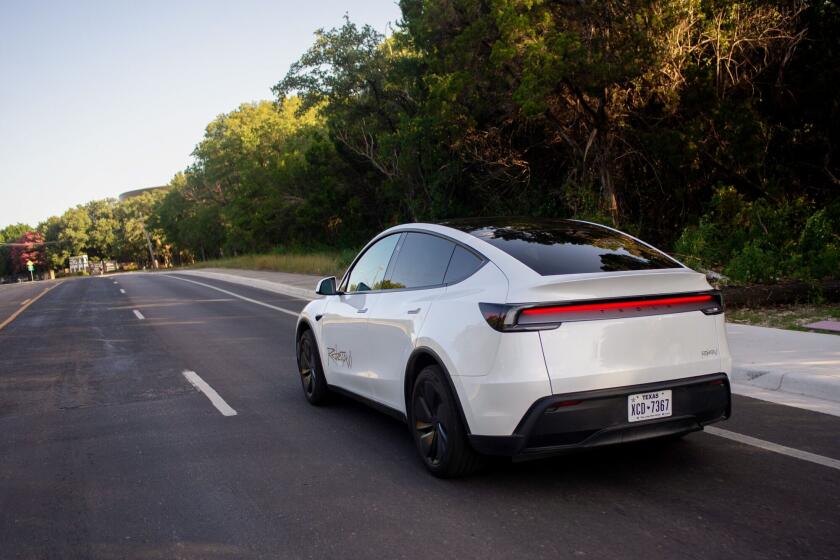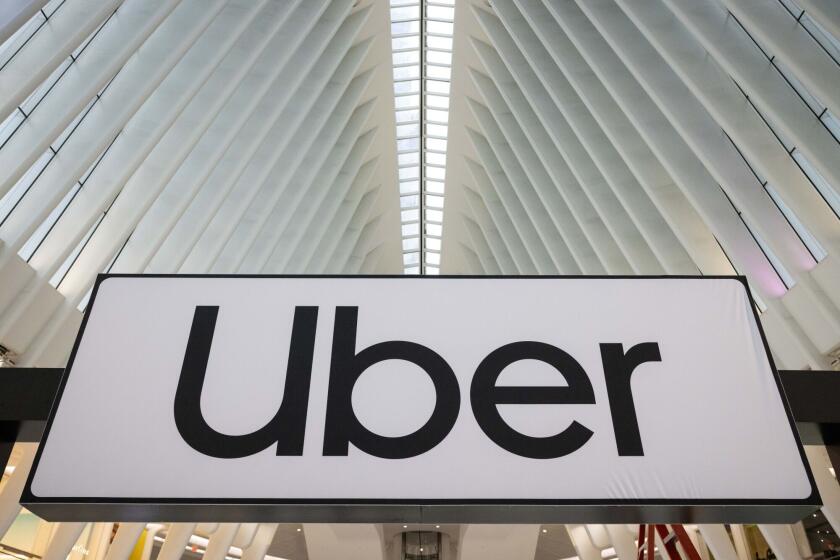2 Trains Collide in Fullerton; 19 Injured
- Share via
FULLERTON — A Metrolink train collided with the tail end of a freight train early Thursday, leaving 19 people injured and shutting down a main rail artery between Los Angeles and Santa Ana traveled by thousands of commuters whose trips were delayed, rerouted or canceled.
“I thought I was going to die,” said Lamont Hawkins, 41, of Long Beach, who was on his way to a Santa Ana interview for a job as a security guard. “Everybody was screaming. I was screaming . . . I’ve never been that scared in my life.”
The worst injuries suffered in the collision were a broken arm and a broken leg, officials said. Fires broke out in the Metrolink engine and several overturned freight cars, but they were quickly extinguished.
Rail officials estimated that the tracks would be cleared and open for train traffic by early this morning.
They said that because the 8:15 a.m. accident occurred after the peak of the morning rush hour and involved a commuter train moving in the opposite direction from most morning traffic, relatively few commuters were affected.
But the afternoon rush hour was a different story: At least 3,500 Amtrak and Metrolink passengers returning south from Los Angeles were diverted through Riverside and San Bernardino to avoid closed sections of track. Some people also were ferried by bus to their stations of origin.
“For a bad situation, this was as good as it gets,” Fullerton Police Sgt. Joe Klein said.
It was not clear what caused the collision of the southbound Metrolink train and a northbound Burlington Northern Santa Fe train less than a mile east of Fullerton Airport near Brookhurst Road.
“What we had was a [freight] train straddling two tracks,” said John Kerins, Metrolink operations director. “The freight train was crossing over, and the passenger train was on the other track.”
Both trains were going significantly slower than the 79-mph speed limit.
The freight train was traveling about 40 mph, and the Metrolink conductor had reduced his speed to 10 mph to prepare for an upcoming switch, officials said.
About 65 people were aboard the Metrolink train, which had left Union Station at 7:54 a.m. for Oceanside. The train was on track No. 2, the westernmost track, and had a green light three miles out from Fullerton Station, the engineer told investigators.
At the same time, the 38-car Burlington Northern Santa Fe freight train was in the midst of switching from track 2 to track 1 just north of the Fullerton station.
The Metrolink conductor told investigators he saw the freight train’s engine pass and assumed the track was clear as he slowed to about 10 mph, Klein said.
Then, as he neared the switch, the Metrolink conductor “saw a wall of train in front of him” and slammed on the brakes, Klein said.
The Metrolink engine hit the 31st car of the 38-car Burlington freight train. Four freight cars derailed, carrying four UPS tractor trailers. The Metrolink train derailed but remained upright. A small diesel fuel fire broke out in its engine, but was extinguished by firefighters.
“Both conductors thought they had the right of way,” Klein said. “But the Metrolink conductor just couldn’t stop in time.”
If everything had worked as it should have, the Metrolink train would have received a yellow/green light at the signal three miles away, warning it that a train was in the crossing ahead, said Lena Kent, Burlington spokeswoman.
Federal railroad authorities, the National Transportation Safety Board and the California Public Utilities Commission will review recording devices in both engines, as well as inspect switching signals on the tracks to determine whether they were working properly or if one of the conductors missed a signal.
“I’m not going to speculate as to who is at fault,” Kent said. She added that the freight train had “the go-ahead,” meaning the green light.
But Metrolink officials said it was impossible for both conductors to have a green light unless there was a signal malfunction.
A second light at the point of collision was red, but it’s unclear when it turned red or at what point the Metrolink conductor saw it, Kerins said.
“It isn’t like a traffic signal,” he said, adding that the lights are not supposed to go directly from green to red. “If he’d had a red light even a half-mile earlier, he should have been able to stop.”
Both conductors will be screened for drugs or alcohol, a routine step in the investigation.
Passengers’ injuries were described as minor. One woman suffered a broken leg. Another, a 24-year-old from Fontana, broke her right arm and was in fair condition. A third woman was treated at a hospital for a bumped head and sprained wrist. Sunshine Holguin, 25, of Norwalk, was aboard the Metrolink train when she heard a series of loud noises and the window next to her shattered.
“There was all kinds of fire,” Holguin said. “Everyone was just pushing and shoving to get out of the train.”
Larry Oats, 39, of Compton, said he was walking down from the upper deck when the train lurched and he fell, tumbling down and seeing flames outside.
“I thought we were going to turn over and flip and it was going to explode,” he said.
The accident left an army of disgruntled commuters and travelers sitting on their suitcases and waiting for buses at the Santa Ana train station.
Brett Banducci, 20, a third-year student at the University of San Diego, bought a $31 ticket to see his parents in San Luis Obispo and boarded the train at 6:47 a.m. The train made it as far as Anaheim, then turned back because the tracks were blocked by the accident.
“I was trying, ironically, to beat the Thanksgiving rush,” said Banducci.
A review of the last five years of Burlington Northern Santa Fe’s safety record shows that in 2,200 train accidents, only 1% were attributed to signal failure. About a third were caused by human error, according to federal statistics.
While accidents caused by signal failure are rare, the current signaling system, experts say, can leave little room for error when the timing of trains is even slightly off.
Times staff writers Megan Garvey, Scott Gold and David Haldane and correspondents Louise Roug and Young Chang contributed to this story.
More to Read
Sign up for Essential California
The most important California stories and recommendations in your inbox every morning.
You may occasionally receive promotional content from the Los Angeles Times.















